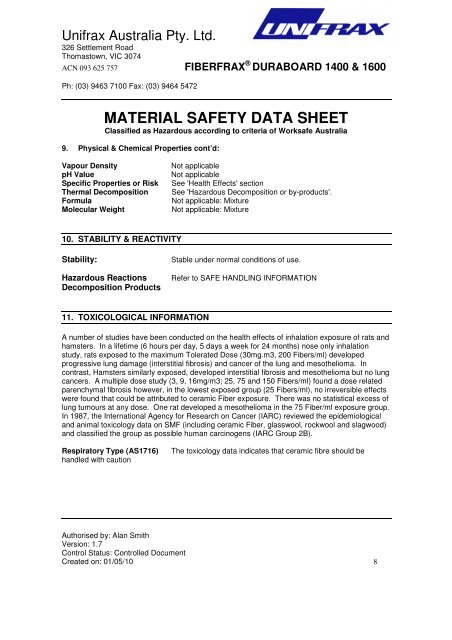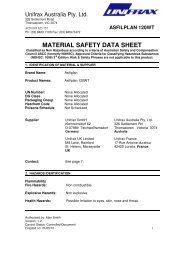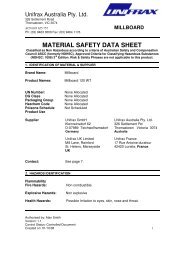MATERIAL SAFETY DATA SHEET - Unifrax Australia
MATERIAL SAFETY DATA SHEET - Unifrax Australia
MATERIAL SAFETY DATA SHEET - Unifrax Australia
You also want an ePaper? Increase the reach of your titles
YUMPU automatically turns print PDFs into web optimized ePapers that Google loves.
<strong>Unifrax</strong> <strong>Australia</strong> Pty. Ltd.<br />
326 Settlement Road<br />
Thomastown, VIC 3074<br />
ACN 093 625 757 FIBERFRAX ® DURABOARD 1400 & 1600<br />
Ph: (03) 9463 7100 Fax: (03) 9464 5472<br />
<strong>MATERIAL</strong> <strong>SAFETY</strong> <strong>DATA</strong> <strong>SHEET</strong><br />
Classified as Hazardous according to criteria of Worksafe <strong>Australia</strong><br />
9. Physical & Chemical Properties cont’d:<br />
Vapour Density Not applicable<br />
pH Value Not applicable<br />
Specific Properties or Risk See 'Health Effects' section<br />
Thermal Decomposition See 'Hazardous Decomposition or by-products'.<br />
Formula Not applicable: Mixture<br />
Molecular Weight Not applicable: Mixture<br />
10. STABILITY & REACTIVITY<br />
Stability: Stable under normal conditions of use.<br />
Hazardous Reactions Refer to SAFE HANDLING INFORMATION<br />
Decomposition Products<br />
11. TOXICOLOGICAL INFORMATION<br />
A number of studies have been conducted on the health effects of inhalation exposure of rats and<br />
hamsters. In a lifetime (6 hours per day, 5 days a week for 24 months) nose only inhalation<br />
study, rats exposed to the maximum Tolerated Dose (30mg.m3, 200 Fibers/ml) developed<br />
progressive lung damage (interstitial fibrosis) and cancer of the lung and mesothelioma. In<br />
contrast, Hamsters similarly exposed, developed interstitial fibrosis and mesothelioma but no lung<br />
cancers. A multiple dose study (3, 9, 16mg/m3; 25, 75 and 150 Fibers/ml) found a dose related<br />
parenchymal fibrosis however, in the lowest exposed group (25 Fibers/ml), no irreversible effects<br />
were found that could be attributed to ceramic Fiber exposure. There was no statistical excess of<br />
lung tumours at any dose. One rat developed a mesothelioma in the 75 Fiber/ml exposure group.<br />
In 1987, the International Agency for Research on Cancer (IARC) reviewed the epidemiological<br />
and animal toxicology data on SMF (including ceramic Fiber, glasswool, rockwool and slagwood)<br />
and classified the group as possible human carcinogens (IARC Group 2B).<br />
Respiratory Type (AS1716) The toxicology data indicates that ceramic fibre should be<br />
handled with caution<br />
Authorised by: Alan Smith<br />
Version: 1.7<br />
Control Status: Controlled Document<br />
Created on: 01/05/10 8






